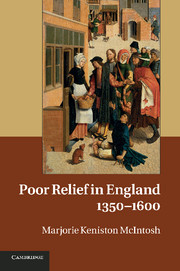Book contents
- Frontmatter
- Contents
- Acknowledgements
- Notes on conventions and online resources
- Abbreviations
- 1 Introduction
- Part I Late medieval and early Tudor patterns
- 2 Seeking alms
- 3 Late medieval hospitals and almshouses
- 4 Aid given through and by the parish
- Part II Profound change during the early Reformation period
- Part III Intensified problems and altered approaches in the later sixteenth century
- Part IV Responding to the problems
- Appendices included in the printed volume
4 - Aid given through and by the parish
Published online by Cambridge University Press: 05 January 2012
- Frontmatter
- Contents
- Acknowledgements
- Notes on conventions and online resources
- Abbreviations
- 1 Introduction
- Part I Late medieval and early Tudor patterns
- 2 Seeking alms
- 3 Late medieval hospitals and almshouses
- 4 Aid given through and by the parish
- Part II Profound change during the early Reformation period
- Part III Intensified problems and altered approaches in the later sixteenth century
- Part IV Responding to the problems
- Appendices included in the printed volume
Summary
One of the institutions through which poor people sometimes received assistance during the later medieval and early Tudor periods was the parish. By the fourteenth century, its lay-elected officers, the churchwardens, were helping to maintain the church building and providing utensils for its services; later they gained additional religious and secular responsibilities. In the early fifteenth century we begin to have good runs of churchwardens’ accounts. Although activity on behalf of the poor may not have been fully reported in their accounts, the records show that some wardens distributed alms donated by other people (gifts from the living or bequests from wills), and in at least a few settings they provided help from funds raised by their own parishes. Their aid joined whatever assistance was given by the chantries or lay religious fraternities housed within the church building and the alms that were sometimes handed out at funerals and commemorative services.
This discussion engages with some recent scholarship arguing that late medieval communities were already carrying out forms of poor relief that earlier historians believed had emerged only with the late Elizabethan Poor Laws. Christopher Dyer linked assistance to the poor with the collection of subsidies, national taxes imposed usually on secular units called vills, but in a few instances on parishes. Beginning in 1334, he noted, communities divided up responsibility for their total subsidy payment among their own members and gathered those sums, delivering them to royal officials. Certain testators in East Anglia made bequests to a “common box” for a fund from which tax payments levied on the vill were made; a few wills left sums specifically for taxes assessed on “the poor of the vill.” Dyer therefore proposed that “the association between tax payment and poor relief is likely to have emerged in the fourteenth century.” He implied that the activities of the vill were joined with those of the parish, that the common box of the former was the same as the box kept by churchwardens. He pointed out also that some parishes were building or acquiring almshouses in the second half of the fifteenth century and that church rates (local taxes) or “leys” were used as early as the 1520s in Prescot, Lancs. In his Ford Lectures of 2001, Dyer made two further suggestions: in years when no subsidy was levied, income from land bequeathed for tax purposes was used to help the poor in other ways; and vills deliberately collected more for taxation than was needed, with the surplus available for distribution to the needy. Other areas of proposed continuity between late medieval and Tudor patterns concern the installation of a special box in the church to collect donations for the poor and some of the techniques used to raise funds for parishioners who needed help.
- Type
- Chapter
- Information
- Poor Relief in England, 1350–1600 , pp. 95 - 112Publisher: Cambridge University PressPrint publication year: 2011



